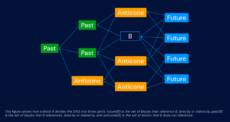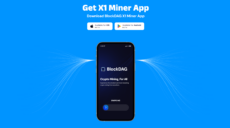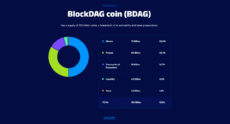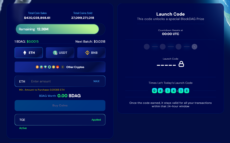In this guide, we explain how to purchase AlphaPepe tokens through the presale and cover key considerations for potential investor...
BlockDAG has caught the attention of the crypto community with its hybrid PoW-DAG technology and great presale success. But is this a legit project, and will a Binance listing happen soon?
BlockDAG has become one of the top new cryptocurrencies to watch in 2025, boasting a remarkably successful presale that has already raised nearly $430 million and sold over 27 billion coins. The tech behind the project is exciting too – it aims to revolutionize blockchain technology by mixing the security of Bitcoin with the scalability of Directed Acyclic Graphs (DAGs), and a Layer 1 Proof-of-Work consensus mechanism.
So far, BlockDAG has over 20,000 miners distributed and over 300,000 BDAG holders. Even though it hasn’t fully launched yet, it’s already a major player in the crypto space and a strong candidate to be one of the best crypto presales in the market.
Still, such rapid growth and ambitious claims have also attracted a lot of skepticism. Critics have pointed to the prolonged presale duration, the launch delays, and other potential red flags. That being said, in this article, we will evaluate the project and its presale progress, sharing our findings about its perks and downsides.
Is BlockDAG Legit? Key Takeaways
- Established project: BlockDAG is a Layer 1 blockchain with a Proof-of-Work consensus mechanism, combining Bitcoin’s security with DAG scalability. The project has already raised over $430 million in its presale, showing strong investor interest.
- Transparent team: The project lists its leadership and advisors with verifiable LinkedIn profiles, which is a green flag.
- Ongoing development: BlockDAG has released a detailed roadmap and regularly gives weekly updates, which show active development and planning.
- Audited smart contracts: The project has implemented smart contracts that have undergone third-party security audits from the trusted firms Halborn and Certik.
- Mixed community feedback and controversial allegations: The project is not without risks. Some have expressed concerns about its prolonged presale and marketing tactics.
Featured Alternative – Editor’s Choice

- First Bitcoin Layer 2 enabling fast, low-cost transactions
- Fixes Bitcoin’s speed and fee limitations with near real-time performance
- Enables a Bitcoin-native DeFi ecosystem
How to Know if BlockDAG Is Legit: Factors to Explore
Determining how legitimate a crypto project is, especially for a project that’s fresh on the market, requires us to look into all of its main aspects.
Team Transparency
BlockDAG’s team is listed on their official website alongside detailed info about each member’s experience in blockchain, fintech, and security. Every name is also linked to a LinkedIn profile that potential investors could check to learn more about their background.

Bios of BlockDAG’s founder and CTO. Source: BlockDAG
Analysis: Having real people listed with verifiable backgrounds is a nice green flag. This shows accountability, but legitimacy also depends on verifying their past achievement and active involvement in the project.
Tokenomics Sustainability
The BlockDAG project has a total of 150 billion BDAG tokens. Half of these are reserved for miners, a third for presale participants, and about 13% for the community and ecosystem. This allocation is designed to encourage long-term use and community growth rather than letting a few crypto whales control everything.
Analysis: A fixed coin supply and clear allocation are very positive signs. Still, it is important to remember that sustainability will be tested by real-world adoption and miner participation.
Innovation and Utility
BlockDAG is not just another blockchain. It uses a Directed Acyclic Graph (DAG) structure, which is meant to improve scalability and speed compared to traditional blockchains like Bitcoin. The main difference is that it can process multiple blocks at once, instead of having to verify them one-by-one. The network also merges Proof-of-Work security with DAG’s efficiency.

Directed Acyclic Graph (DAG) explained. Source: BlockDAG Whitepaper
The platform supports EVM compatibility, meaning developers can easily deploy Ethereum-based smart contracts on BlockDAG. They also offer low-code development tools for token and NFT creation, making it easier for non-technical users to participate.
Finally, the ecosystem is designed for mining accessibility with support for both ASIC miners and its own mobile mining app, so you can mine BDAG coins without extensive technical knowledge.

Graph detailing BlockDAG’s directed acyclic graph tech from its whitepaper
Analysis: BlockDAG’s use of DAG and hybrid Proof-of-Work is promising. Still, this is a project in its early phases, and the real measure of legitimacy is whether these innovations are actively deployed and used by the community.
Security and Audits
BlockDAG has undergone audits by firms like CertiK and Halborn. These audits check the smart contracts and treasury systems for vulnerabilities. Passing them doesn’t guarantee success, of course, but it’s a strong signal that the project takes security seriously.
Audits: Third-party audits are crucial, but legitimacy depends on public transparency of results, prompt addressing of vulnerabilities, and continuous updates to maintain network security.
Revenue Framework
The BlockDAG presale has raised over $430 million, selling more than 27 billion BDAG tokens in stages. Strong funding like this shows that there is significant interest in the project, which could certainly help it grow and develop.
Analysis: A structured revenue system via mining and presale participation is a positive signal. Legitimacy still requires checking that the system actually delivers the promised rewards fairly and consistently over time.
Fairness and Transparency of the Presale Structure
The presale is split into phases. It has gradual price increases for each batch. This gives early participants the chance to get in without unfairly disadvantaging later investors. Keeping these price increases relatively low could help prevent large scale dumping soon after launch as well.
There are also measures like multi-signature controls and time-delayed executions set in place to protect the funds.
Analysis: Clear presale phases and allocations are good, yet legitimacy will hinge on whether early participants truly get equal access, and if the project will stick to its promised roadmap.
About BlockDAG: Analyzing the Project
To better help you decide if this project is trustworthy and if you should invest in it, we took a closer look at its tokenomics, roadmap, compliance, and marketing strategies.
Tokenomics
BlockDAG’s tokenomics are transparent, with a total supply of 150 billion BDAG coins and clear allocations for miners, the team, and community incentives. The BDAG coins are divided into several allocations:
- Miners: 75 billion (50%)
- Presale: 50 billion (33.3%)
- Community and ecosystem: 19 billion (12.7%)
- Liquidity: 4.5 billion (3%)
- Team: 1.5 billion (1%)
This structure suggests that BlockDAG is trying to reward those who actually contribute to the network’s functionality (miners and community members). The team’s 1% share, locked for two years, is notably smaller compared to other projects (which often reserve much larger cuts for the founders). This is a positive sign, as it points toward a focus on community value.
Another strength is the community-oriented allocation, with nearly two-thirds of the total coins going back to the ecosystem, miners, and liquidity pools. This shows a clear commitment to ensuring the token isn’t controlled by a small number of insiders.
However, the high overall coin supply could raise inflation concerns. Also, the 50% allocation for miners shows an emphasis on decentralization, but such high numbers also make us question the token’s long-term price stability.
What really matters here is whether the mining rewards and liquidity support are sustainable once the presale ends. If the rewards are distributed fairly and the inflation stays under control, the system could certainly hold up. Still, this is something to watch closely as the project matures.

BlockDAG (BDAG) tokenomics. Source: BlockDAG
Roadmap
The BlockDAG roadmap gives insight into how far BlockDAG has come and where it is heading. According to the project’s official timeline, the Phase 1 roadmap (from January to November 2024) has already been completed. It included:
- Team formation and core blockchain development
- Launch of the Testnet (Alpha)
- Explorer, Faucet, and Node setup
- Completion of BlockDAG 1.0 and its audit phase
Moving into Phase 2, which spans 2025, the focus has shifted to expansion and upgrades, as can be expected. The key upcoming developments include:
- Blockchain feature modules: Fee customization, sharing, and analytics
- Stablecoin integration (USDT, USDC)
- DeFi features like staking, swaps, bridging, and lending
- Low-code IDE and Launchpad for token and NFT creation
- Final testnet and mainnet launch with security audits
What stands out here is the weekly release schedule. Every Monday, new development updates are posted. This level of transparency is rare in such projects and shows just how active the development team is, despite the delays.
On BlockDAG’s official site, you’ll find references to a “Road to Listing” and a “Binance Live AMA” scheduled, which suggests the team is positioning for a potential Binance listing as an upcoming milestone.
Marketing Strategy
BlockDAG’s marketing approach seems intentionally understated. Instead of pushing aggressive paid campaigns or celebrity endorsements, the project seems to be leaning on community engagement. Their official Development Releases page shares weekly updates and invites the community to contribute ideas or participate in open-source projects.
There is also the tone across their channels, especially the Developer Hub. This reflects a focus on building credibility through progress, not hype. In many ways, this positions BlockDAG as a long-term infrastructure project and not a quick-turn token launch.
Still, it is very early to determine anything, considering that the project is still in presale. As the mainnet launch approaches, we need to keep track of exchange listings and strategic partnerships, as well as clear educational content for investors who may not fully understand DAG-based blockchains.
Legality and Presale Compliance
From a compliance perspective, BlockDAG is very clear about its presale structure, breaking down coin distribution and the purpose of each allocation.
The presale offers early supporters a chance to participate before the public launch, often with better prices. This is not uncommon for new crypto projects.
Still, there are some due diligence points worth noting here, too. While BlockDAG presents itself as a legitimate blockchain project with public-facing developers, the official website does not specify a corporate registration location or license details. Many projects openly display these numbers to build investor confidence.
Now, this lack of documentation doesn’t necessarily make it suspicious, but it does leave somewhat of a gap in transparency.
The positive side is that the project commits to third-party security audits for smart contracts and the final mainnet.
How to Buy BlockDAG Tokens Safely
If you decided to buy BDAG, here is a step-by-step guide to do it:
- Prepare your wallet and some crypto. Use a compatible wallet like Best Wallet and make sure you have enough of a supported token (like ETH, BNB, or USDT) in that wallet.
- Visit the official presale site. Click on “Buy Now” and connect your wallet.
- Choose the payment method and amount. Select which crypto you want to use to buy BDAG and enter the amount. Double-check everything and approve the transaction.
When you make your order, the TGE code will be automatically applied. After three purchases, you will receive a special promo or launch code that must be used within 24 hours. On your fourth and future purchases, entering the code might unlock discounts, bonus tokens, or priority access during the presale.

BlockDAG presale homepage. Source: BlockDAG
Comparing BlockDAG to Other Presale Projects
To better understand the legitimacy of the project, we also looked at other trending presale projects on the market.
First, there is Bitcoin Hyper (HYPER), a viral project building a Layer 2 network on top of Bitcoin. Bitcoin Hyper’s plan is to use a custom implementation of the Solana Virtual Machine to bring smart contracts and high throughput to Bitcoin’s chain.
The similarity to BlockDAG is clear: both projects are infrastructure plays and not just memes. They both try to combine strong security (Bitcoin or PoW) with newer, scalable architectures. The main difference, aside from the tech itself, is that Bitcoin Hyper also harnesses memes to build its community, while BlockDAG seems to be entirely focused on utility.
Another example is Maxi Doge (MAXI). This is more of a meme/utility hybrid token that targets the hype arena, but also offers staking, burn mechanics, and has a well-structured presale. The similarity to BlockDAG is less on the technical side and more on the presale and community dynamics. Both projects are running presales with frequent stages and heavy reliance on narrative and momentum.
Conclusion: Is BlockDAG a Legit Project or a Scam?
Based on everything we uncovered here, BlockDAG seems like a legitimate and extremely well-funded project. However, it is still early, and as such, this project carries the usual high risks of new crypto projects.
The project checks off many of the right boxes: a public and verifiable team, consistent updates, transparent tokenomics, and audited smart contracts. These are all good signs.
That being said, there are a few reasons to stay cautious. The extended presale and the lack of clear corporate registration details leave some room for concern. Plus, as with any early-stage crypto project, what really matters here is execution: whether the team delivers on the mainnet and provides real-world utility.
If BlockDAG keeps its current pace and fulfills its roadmap, it could end up being one of the more promising altcoin projects on the market, and maybe even the next 1000x crypto. Still, like with any crypto investment, the risk is real, and it is best to do your own research and never invest more than you can afford to lose.
FAQ
What is BlockDAG?
Is BlockDAG a legitimate project?
Why is the presale taking so long?
How can I buy BDAG tokens?
Is BDAG mineable?
When will the mainnet launch?
References
- Directed Acyclic Graph (DAG) – Crypto.com
- What Are EVM Compatible Blockchains – Thirdweb
- BlockDAG Coin (BDAG) Allocation Explained – BlockDAG Tokenomics
- Understanding Crypto Whales: Impact on Market Liquidity and Price – Investopedia
- DAG vs. Blockchain – Hedera
- Understanding Proof of Work in Blockchain – Investopedia
- BlockDAG External Audit 2 – CertiK
- BlockDAG External Audit 1 – Halborn
- Tokenomics Explained – Coinbase
- What Are Liquidity Pools – Gemini
Coinspeaker in Numbers
Monthly Users
Articles & Guides
Research Hours
Authors
Super Pepe (SUPEPE) is a 2025 meme coin with a charitable twist. In this post, you will discover some realistic price scenarios, a...
AlphaPepe has quickly become one of the more talked-about meme presales, thanks to the instant token delivery, active community, a...
 Fact-Checked by:
Fact-Checked by:
 13 mins
13 mins
Nadica Metuleva
, 39 postsI’m a seasoned writer with over a decade of professional experience, specializing in crypto, technology, business, and iGaming. Over the years, I’ve built a reputation as a trusted contributor to well-known outlets such as InsideBitcoins, CEOTodayMagazine, and Promo, while also collaborating with leading content and marketing agencies including Skale and Boosta. My portfolio spans a wide range of content types, exchange reviews, how-to guides, long-form comparisons, trend analyses, and thought leadership pieces, crafted to both inform and engage readers across different levels of expertise.
In the crypto space, I’ve developed a deep understanding of blockchain technology, digital assets, and the fast-moving decentralized finance (DeFi) ecosystem. I’ve written extensively on topics such as cryptocurrency exchanges, wallets, tokenomics, NFTs, and global regulatory developments. As a crypto investor myself, I bring a valuable firsthand perspective that allows me to balance technical accuracy with practical insights that resonate with traders, investors, and newcomers alike. Whether I’m breaking down blockchain mechanics or analyzing the latest market shifts, my work combines rigorous research, industry knowledge, and a keen sense of storytelling.
My educational background plays a key role in shaping my writing approach. I hold a Bachelor’s degree in Translation and a Master’s degree in English Literature and Teaching, disciplines that sharpened my ability to research complex subjects, distill technical information into accessible language, and adapt my tone to diverse audiences. This strong academic foundation underpins my clear, insightful, and authoritative style.
Passionate about making complex topics accessible, my mission is to cut through the jargon and deliver content that empowers readers to make informed decisions.
You can learn more about me and explore my portfolio on LinkedIn.